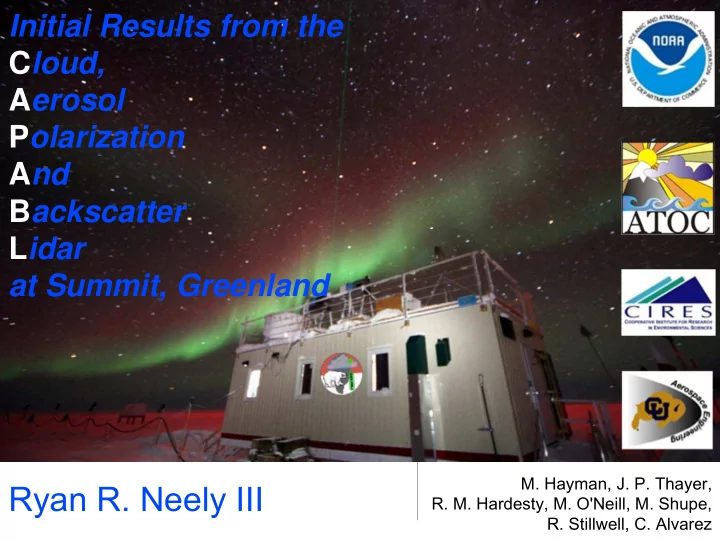

Initial Results from the C loud, A erosol P olarization A nd B ackscatter L idar at Summit, Greenland M. Hayman, J. P. Thayer, Ryan R. Neely III R. M. Hardesty, M. O'Neill, M. Shupe, R. Stillwell, C. Alvarez
Why did we put this lidar at Summit? • I ntegrated C haracterization of E nergy, C louds, A tmospheric state, and P recipitation at S ummit (ICECAPS) • Clouds affect the Mass and Energy Budget of the Greenland Ice Sheet • How do clouds impact the Greenland Ice Sheet? • Source: Precipitation => Mass Budget • Sink: Radiation => Energy Budget • Significant sea level rise is predicted from a melting Greenland Ice Sheet Last Ice Age Present Future?
What are we observing? Cloud and precipitation phase Thanks to Ed Stockard for all the photos.
How Do We Determine Orientation of Scatterers in CAPABL Polarization Measurements? • CAPABL is polarization lidar described by the stokes vector lidar equation: • When scatters may be assumed to be randomly oriented the depolarization ratio is derived as: • where is the randomly oriented backscatter matrix. • • • When scatters are not randomly oriented the depolarization ratio is derived as: • where is the oriented backscatter matrix. •
We measure 3 planes of polarization to improve cloud property retrievals. • By measuring N 45 , we qualitatively determine if the scatters exhibit orientation through a quantity known as diattenuation : • Diattenuation allows us to unambiguously infer the form of the scattering matrix. = 0; ≠ 0;
CAPAB L Transmits Single • Triple linear polarization Linear Polarization Receiver measurement • 30m spatial and 5s temporal resolution Transmitter Doubled Nd:YLF 523.5nm Diode Pump • 24/7 automated operations Rotates between with remote access. Parallel, 45 and Computer Perpendicular and Polarization States DAQ
CAPAB L Transmits Single • Triple linear polarization Linear Polarization Receiver measurement • 30m spatial and 5s temporal resolution Transmitter Doubled Nd:YLF 523.5nm Diode Pump • 24/7 automated operations Rotates between with remote access. Parallel, 45 and Computer Perpendicular and Polarization States DAQ
Example Observation Seeder- Clear Air Total Linear Depolarization Ratio Feeder November 15, 2010 November 15, 2010 Cloud Liquid Ice Layer (High δ ) (Near Lidar Backscatter Ratio Zero δ and High LBSR )
Linear Diattenuation Observation of Diattenuation • On 18 February 2012, CAPABL observed two diattenuation signatures (Light blue in top Total Linear Depolarization Ratio panel). • Cirrus cloud • Expected regime for oriented crystals as shown by observations from CALIPSO • Cumulus Total Backscatter • Unexpected particle orientation due to turbulence from strong precipitation • Enhancement of linear depolarization in area of strong diattenuation
Conclusions • CAPABL can simultaneously determine: • Cloud phase (linear depolarization ratio) of randomly oriented scatterers • Variations in the diattenuation of the scatterers, which may be used to interpret the presence of HOIC. • Diattenuation measurements improve the overall quality of cloud phase measurements (less than 2% error in linear depolarization ratios) by reducing uncertainty about the orientation of scatterers. • Current observation provides a first demonstration of operationally detecting HOIC by direct polarization determination.
Thank You
Where did we put it? • Summit Station • Peak of the Greenland Ice Cap (3.2km a.s.l) • 400km from coast • 72°34'44.10"N 38°27'34.56"W NSF’s Mobile Science Facility
Ability to measure oriented ice crystals is dependent on pointing angle of lidar. Diattenuation Backscatter n o ) Resolution Wave Vector of i ) t r u s l o Lidar m s ( e / R 1 ( / r n e o t i t t a a c u s n k e c t a Polarization t a B i D Oriented Crystal Pointing Angle of Lidar Measured from Zenith (degrees) Angle of Beam from Zenith
Self Validation of Diattenuation Measurement Against Instrumental Effects • Integrated profile from 5:30 to 6:00 UTC on February 18, 2012 (a section from the whole day shown in pervious slide ). • Using the liquid crystal rotator we can make a second measure of diattenuation using another set of off diagonal elements form the scattering matrix. • This allows for the two measures of diattenuation to be influenced differently by detector saturation. • Regions where both diattenuation profiles track together, above the error limits , contain positive detection of diattenuatting scatterers. • Regions where the two diattenuation profiles behave oppositely, as is seen in the bottom of the profile, is due to detector saturation.
Diattenuation help lidar observations to be more accurate in other ways. Corrected D q Log 10 (N) D q Corrected δ δ Strong Backscatter introduces 2.0 error to data products due Altitude Above Summit(km) to nonlinear detector gain (pulse pile up). 1.5 Nonlinearity may be solved for because diattenuation detected in 1 zenith direction is defined as zero. 0.5 Corrected backscatter counts produce more 0 accurate data products. -0.05 0 0.05 0.1 0.15 0.2 0.25 0.3 0.35 Polarization Ratio/Relative Backscatter Dynamic range of backscatter detection is increased by an order of magnitude.
Recommend
More recommend